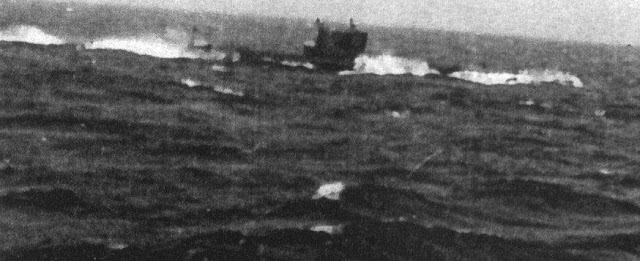 |
| Figure 1. Equipment in the far end of Skeena’s wireless office. A medium frequency transmitter sits at left with its coils above. An HRO receiver is at right. |
 |
| Figure 2. CM-11 transmitter-receiver. |
 | |||
Figure 3. Marconi MSL-5 receiver used in Skeena for receiving messages broadcast from shore stations on 105 or 107 Kc/s. |
 |
Figure 4. FR-12 transmitter-receiver, used largely on the convoy wave of 2410 Kc/s for radio-telephone communication between escorts. |
 |
Figure 6. PV500 transmitter used for transmitting messages ship-to-shore on such frequencies as: 4740, 6300, 8290 and 12685 using morse. |
 |
| Figure 7. Royal Navy submarine off the coast of Nova Scotia |
 |
Figure 8. Riley leaning on iced-up A gun aboard Skeena, December 1942. |
 |
Figure 9. Leading Telegraphist Fred Ross, Skeena. The photo was taken using sunlight shining through the port hole. |
 |
Figure 10. Telegraphist Tom Clegg, Skeena. |
 |
Figure 11. Coders Bruce Witherspoon and Ritchie Seath, Skeena 1943. Ritchie lost his life when Skeena went on the rocks at Iceland in October 1944. |
 |
Figure 12. Telegraphist George Godsall, Skeena 1943. |
 |
Figure 13. Telegraphists Allan Riley and Frank Hibbs, Skeena, Oct 1942. |
 |
Figure 15. St. Hyacinthe W/T students operate a portable radiotelephone set. L to R: Bruce Stevenson, Kimberley BC, J.R. Walker, Toronto ON, and Charles Cannon, Windsor ON. |
 |
Figure 16. Wireless Telegraphy students copying plain language morse of SBX (Standard Buzzer Exercise) at St. Hyacinthe. |
 |
Figure 17. Ratings at St. Hyacinthe are restoring books to the shelves in the Confidential Book office. |
 |
Figure 18. Wrens wireless telegraphy class copying morse on typewriters, obviously a much better method than pushing a pencil. |
 |
Figure 20. The ship’s company doubling to “divisions” at St. Hyacinthe. Wrens can be seen streaming from behind the building at the top. |




Robert "Bob" Clarke is my wife's stepdad. Bob passed in 2010. Bob left behind 6 months of handwritten log of the part played in the invasion of the conterment on June 1943 by the H.M.C. Destroyer "SKEENA" I-59. His log starts on April 29th arriving in Londonderry after having evolutions in St. Margrets Bay, N.S. His log ends on July 31st at 0323.Reading Robert's pages is like watching a movie. It is amazing, humbling,happy at times and yet terrifying with Bob's descriptions of "glider bombs" overhead, I miss you Bob. We love you, we miss you and thank you for your patronage for your countrymen and women.
ReplyDeleteRobert "Bob" Clarke is my wife's stepdad. Bob passed in 2010. Bob left behind 6 months of handwritten log of the part played in the invasion of the conterment on June 1943 by the H.M.C. Destroyer "SKEENA" I-59. His log starts on April 29th arriving in Londonderry after having evolutions in St. Margrets Bay, N.S. His log ends on July 31st at 0323.Reading Robert's pages is like watching a movie. It is amazing, humbling,happy at times and yet terrifying with Bob's descriptions of "glider bombs" overhead, I miss you Bob. We love you, we miss you and thank you for your patronage for your countrymen and women.
ReplyDelete